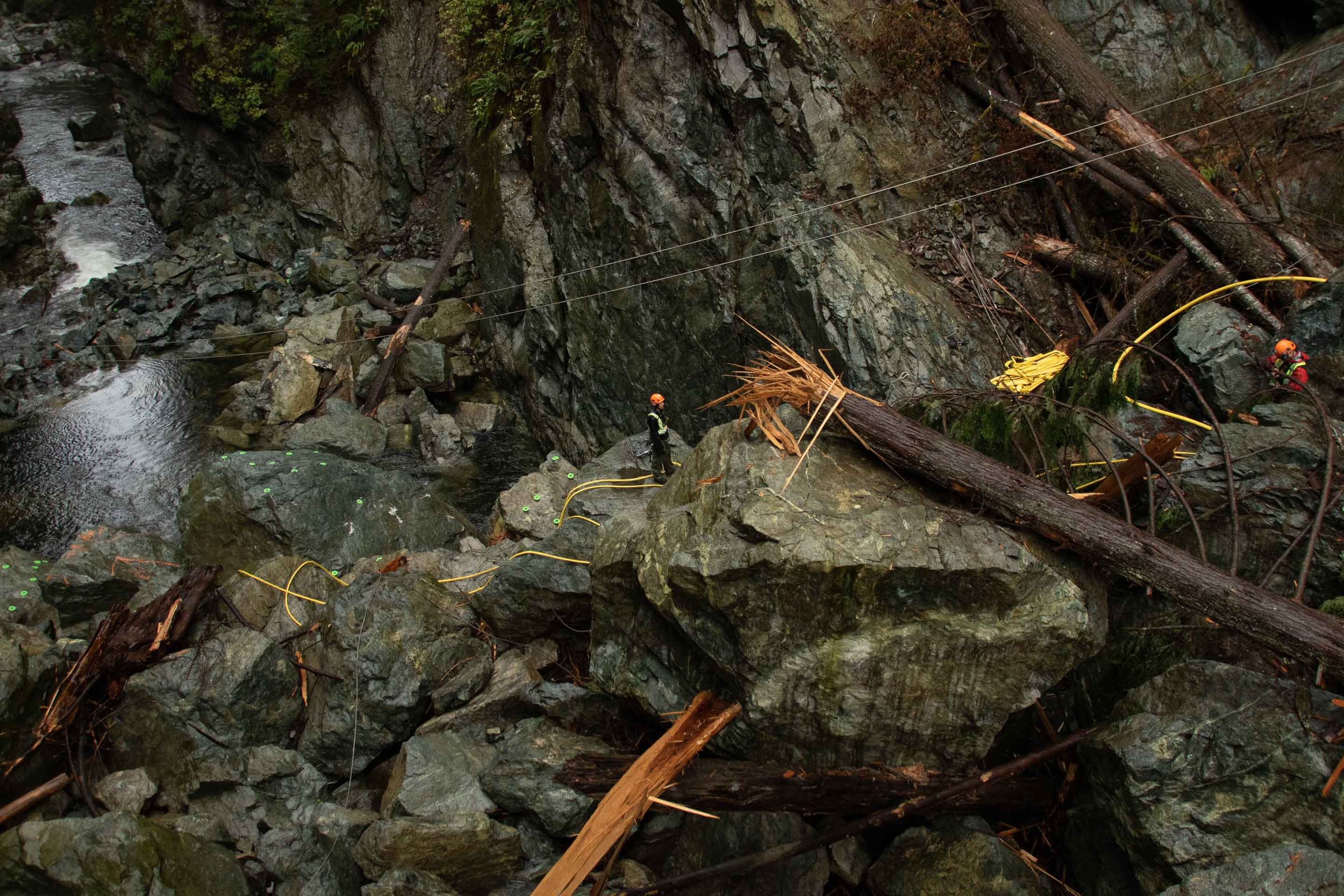
The clamour of hammer drills bounces and reverberates off the sheer rock walls of North Vancouver’s Seymour River Canyon and into the thick rainforest canopy. Down below, workers scurry like ants in high-vis work vests as they haul bright yellow air hoses and air drills beneath an immense rock scar where a 200-foot buttress once leaned out over the river.
That buttress, over 50,000 cubicmetres of rock, came crashing down on December seventh, 2014 and filled the Seymour Canyonwith debris, effectively blocking passage for anything except the persistent flow of water. A situation that is not ideal for the salmon jumping downstream from the slide or the Seymour Salmon hatchery.
The Seymour Hatchery was built in 1977 to counteract the deficit observed in the salmon population following construction of the Seymour Falls Dam. The Seymour Salmonoid Society (SSS), a dedicated group of volunteers took over operations of hatchery in 1987, after initial funding began to dissolve. As informal stewards of the waterway, Smith and the SSS were left to the task of getting the ball rolling and undoing a massive geological event.
Over 80,000 fish (Steelhead and Coho) have 100 per cent of their spawning habitat above the rockslide. “If nothing is done, a lot of themwill die as a pre-spawnmortality,” explains Brian. “They will leave the system entirely, looking for a new location to spawn, or they’ll try to spawn below the slide where the habitat can’t support it.
When he arrived on site and first saw the effects of the slide Smith remembers feeling his heart sink. ““This was more then a problem, at the moment all I could think was; something has to be done. But what? And how?”
“ We were looking at losing the entire Steelhead population by 2019
and only remnants of Coho would remain.”
The first step was organizing a round table involving all concerned parties, stakeholders in the health of the salmon run; this collective was comprised of members of the District of North Vancouver, the City of North Vancouver, Metro Vancouver, Department of Fisheries and Oceans, the B.C. Provincial Government –as well as the two First Nations Bands whose territory the Seymour River passes through, the Skwxwu7mesh(Squamish) and the Tsleil-Waututh(SLAY-wah-tooth).
“We all came together and formed a partnership,” Smith says.,“with the one goal being to reintroduce migration passage through the Seymour canyon for adults and juvenile salmon alike.”
Northwest Hydraulic Consultants was brought in to advise on possible next steps. They brought nine options to the round table and by the end of the discussion the members had agreed on using a low-velocity rock breaking product to reduce the size of the debris, allowing the natural flow of the river to disperse and reshape the waterway. Those worker-ants in the box canyon are operating 45-pound pneumatic rock drills that average about 2,200 blows per minute at 90 PSI (that’s the equivalent to drilling a hole the height and width of a stop-sign post in about an hour).
“A continuous circuit of yellow blasting wire leads out of the canyon to a safe zone and the high-vis ants scurry over the boulders, evacuating the canyon while salmon jump in the waters below the slide, excited and impatient to continue upstream.”
Transporting equipment like that over flat ground is a labourious task in itself. To get them down a cliff and over the debris to the toe of the slide requires a web of ropes, pulleys and expertise to ensure safety. To properly clear the debris will require 1.2 million dollars over 5 years and the Not-for-Profit SSS (with it’s humble staff of three fulltime employees and one seasonal aid) areexpected to raise the money, on top of the regular duties of the hatchery. For the past two years Brian Smith’s life has been bound in the shackles of bureaucracy and fundraising. It seems the fate of the Seymour Salmon is now hinged on the countless e-mails and funding proposals of one man.
But in the canyon; progress. As the team prepares for a blast the canyon buzzes with activity; charges, sand and blast wire are all lowered down to the prepared boulders and as they arrive are loaded, packed and wired together to form a continuous circuit of yellow blast-wire leading out of the canyon to a safe-zone where the blast will be triggered from. Salmon are jumping in the waters below the slide, excited and impatient, trying to get a glimpse of the activity happening upstream. The ants scurry over the boulders evacuating the canyon, a few moments later an air horn sounds 12 times in short succession, a two minute warning. As anticipation peaks, gasses ignite and expand instantaneously, seeking weaknesses in the rock, pushing outwards until –with a pop- the boulders crumble. Smoke rises from the canyon, the salmon jump again, checking on the progress, to see if their way home has been cleared -but behind the three truck sized boulders that have just been transformed into a pile of rubble, a few dozen more sit unmoved and indifferent. The salmon will have to be patient with us.
For more info or to donate hit up http://seymoursalmon.com/
Mountain Life: Coast Range 2017